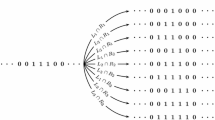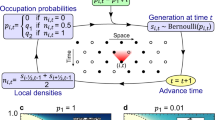Abstract
We consider the finite homogeneous Markov chain induced by a class of one-dimensional asynchronous cellular automata—automata that are allowed to change only one cell per iteration. Furthermore, we confine to totalistic automata, where transitions depend only on the number of 1s in the neighborhood of the current cell. We consider three different cases: (i) size of neighborhood equals length of the automaton; (ii) size of neighborhood two, length of automaton arbitrary; and (iii) size of neighborhood three, length of automaton arbitrary. For each case, the associated Markov chain proves to be ergodic. We derive simple-form stationary distributions, in case (i) by lumping states with respect to the number of 1s in the automaton, and in cases (ii) and (iii) by considering the number of 0–1 borders within the automaton configuration. For the three-neighborhood automaton, we analyze also the Markov chain at the boundary of the parameter domain, and the symmetry of the entropy. Finally, we show that if the local transition rule is exponential, the stationary probability is the Boltzmann distribution of the Ising model.
Similar content being viewed by others
References
O. Häggström, Finite Markov Chains and Algorithmic Applications, Cambridge University Press: Cambridge, UK, 2002.
M. Iosifescu, Finite Markov Processes and Applications, Wiley: New York, 1980.
G. Keller, Equilibrium States in Ergodic Theory, Cambridge University Press: Cambridge, UK, 1998.
H. Mühlenbein and R. Höns, “Stochastic analysis of cellular automata with application to the voter model,” Advances in Complex Systems vol. 5 pp. 301–337, 2002.
N. A. Oomes, “Emerging markets and persistent inequality in a nonlinear voter model.” In D. Griffeath and C. Moore (eds.), New Constructions in Cellular Automata, pp. 207–299, Oxford University Press: Oxford, 2002.
F. Schweitzer (ed.), “Applications of cellular automata in complex systems,” Advances in Complex Systems vol. 5 pp. 101–337, 2002.
E. Seneta, Non-negative Matrices and Markov Chains, Springer-Verlag: New York, 1981.
S. Wolfram, Cellular Automata and Complexity, Addison-Wesley: Reading, 1994.
Author information
Authors and Affiliations
Corresponding author
Rights and permissions
About this article
Cite this article
Agapie, A., Höns, R. & Mühlenbein, H. Markov Chain Analysis for One-Dimensional Asynchronous Cellular Automata. Methodology and Computing in Applied Probability 6, 181–201 (2004). https://doi.org/10.1023/B:MCAP.0000017712.55431.96
Issue Date:
DOI: https://doi.org/10.1023/B:MCAP.0000017712.55431.96




